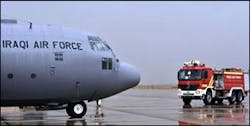American, Iraqi Firefighters Work to Protect Baghdad Airport
NEW AL MUTHANA AIR BASE, Iraq -- As senior government leaders hammer-out a new Status of Forces Agreement that will set the path for future American and Iraqi military policies, a group of American and Iraqi firefighters have already developed a working relationship that creates ties and also helps protect people, structures and aircraft at Baghdad International Airport.
U.S. Air Force firefighters from the 447th Expeditionary Civil Engineer Squadron at Sather Air Base and Iraqi air force firefighters from New al Muthana Air Base are learning how to work together to protect life and property in the event of any type of ground or in-flight emergency.
The most recent training paired the American and Iraqi firefighters in an exercise where they practiced the procedures for rescuing the flight crew from a C-130 Hercules transport aircraft in the event of a fire in the cargo hold.
The training began with the firefighters meeting for a briefing to discuss the objectives of the exercise including aircrew egress procedures and how to integrate their rescue and firefighting processes.
"We used an Iraqi air force C-130 for the training, and the Iraqi firefighters took the lead in entering the aircraft," explained Chief Master Sgt. John Cinquemani, 447th ECES fire chief. "It's important to learn about each other's capabilities and become familiar with the different equipment that's used so we can integrate into one team in the event of any type of emergency. We have to have one common goal and one common process in order to save lives and get the job done."
Chief Cinquemani explained that working firefighting activities at an airport offers a unique set of challenges and dangers as compared to a regular city fire department. He is deployed from the 105th Airlift Wing at Stewart Air National Guard Base in New York, where he serves as the full-time fire chief for the Guard Base as well as Stewart International Airport. With more than 37 years as a firefighter and 23 years as a fire chief, he understands those challenges and dangers, and pushes both the American and Iraqi firefighters to learn how to work together.
To that end, the chief is planning weekly training and exercises that will encompass a vast range of crisis scenarios and push the firefighters to perform as a seamless team. "If we have an emergency on the Iraqi air force side of the airfield or involving an Iraqi aircraft, then they will take the lead and we will back them up," he said. "If it involves an American aircraft, they have our backs--and it takes constant training be ready."
When the training began, the call went out over the radio announcing an emergency response to a simulated fire aboard the Iraqi aircraft. The Iraqi and American fire trucks rolled out across the taxiway and took staggered positions around the aircraft. With the American's wearing silver protective suits and the Iraqi's wearing black, they worked together to pull hoses off of the Iraqi trucks and prepare to enter the aircraft.
The Iraqis manned the hoses and stood by as American firefighters counted down and then yanked open the aircraft door. The Iraqis immediately pushed through the opening with their hoses and began clearing procedures, followed by their American back-up.
Once the aircraft was cleared, the teams gathered to discuss what they did well, and what they could do better. "We still have to overcome the language barrier and do better in coordinating our actions so we all move and act together," said Staff Sgt. Jason Ankenbauer, 447th ECES firefighter, who is deployed from the 144th Fighter Wing at Fresno Air National Guard Base, Calif.
"When you are dealing with an aircraft fire, there are lots of other things to consider including the fact that you have to work very quickly -- not only to save lives but because it's a three-dimensional environment and there are always going to be other activities around the emergency area and multiple aircraft overhead that are waiting to land." Sergeant Ankenbauer also said that their training will allow them to be better prepared to assist the civilian Iraqi firefighters on the Baghdad International Airport side of the flightline in the event of a major civilian aircraft crash, fire or mass-casualty incident.
Chief Cinquemani praised the firefighters for staying focused on their task, and doing their best to move as a team. He then explained that he is working on a project to make sure all American and Iraqi firefighters get the same self-contained breathing equipment so they can more effectively team-up while working and training together.
Chief Cinquemani's plans for additional exercises and training include scenarios that will call upon American and Iraqi firefighters as well as medical personnel from the 447th Expeditionary Medical Squadron.
"The Iraqi air force firefighters are obviously very proud of their accomplishments, and every step we take with them in training is another step towards their capability to take over all of the military emergency services activities here. Each of their accomplishments also brings them one step closer to becoming a fully independent and operational air force," chief Cinquemani said.
